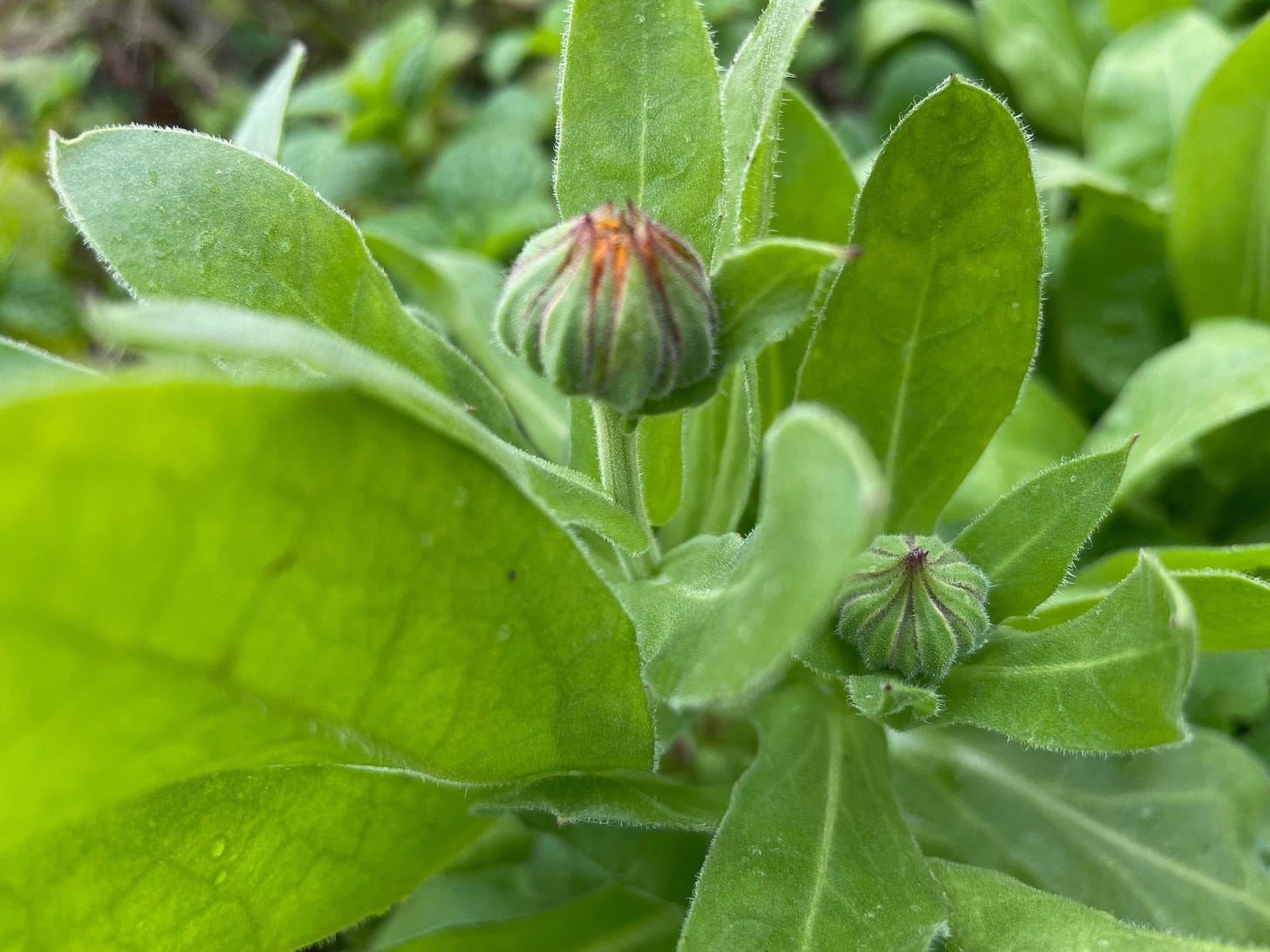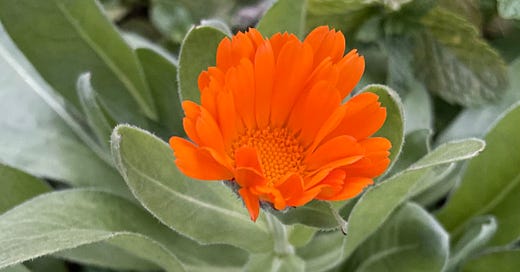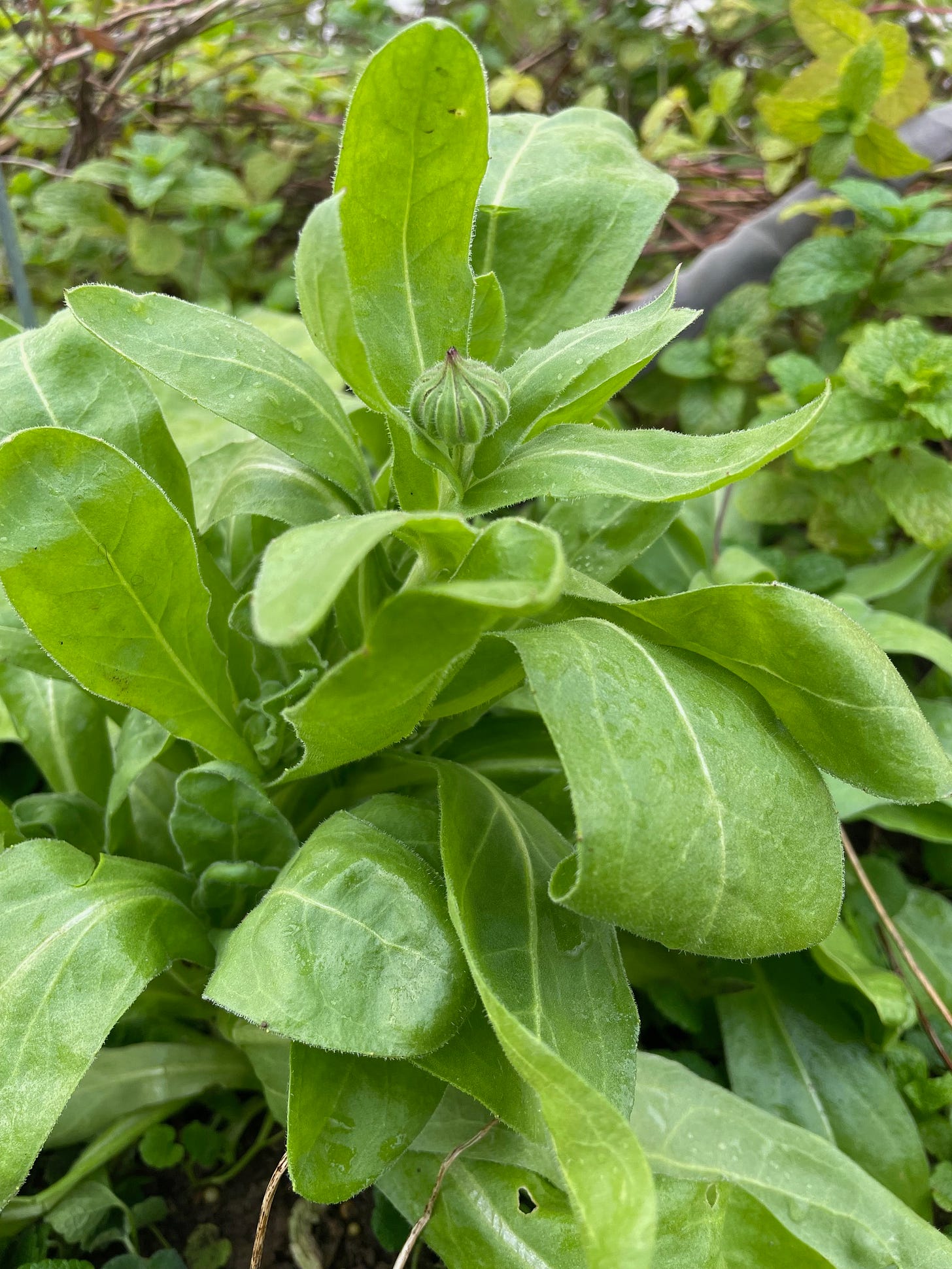At weedom there is freedom to ignore the calendar. Last Fall it was the chamomile that we overwintered. This year, its the Calendula, to which we are attending instead. Despite their slow start, these plants are able to bloom during the short days and low light, so we don’t have to wait ‘til spring as we did with the chamomile. Our Calendula began life from some old seeds that were scrounged up from a prior summer’s planting, stuck into some cells of potting soil in August. The little plants languished awhile, totally hating on their formulated substrate, ‘til they were moved to the greenhouse, where they experienced an immediate growth spurt in the cow poo fortified soil. Then some verminous creature ate them all down to a nub. The calendula recovered quite well, in a couple weeks, but the cursed creature came back for a second meal. With the normal growing season at an end, we gave up hope, but decided to cover them at the same time as the salad greens which were sprouting up.
After 2 grievous assaults, 90 percent of those calendula plants have survived, half of them have buds, and one of them has bloomed.
We’re eating salad all the way through December as we usually do. This year we get to throw in a few special leaves from the Calendula, which is edible as well as medicinal. It’s providing us some solace as a replacement for the chickweed which is very sparse after our previous dry seasons.
Though Calendula officinalis is called “pot marigold” due to it’s use as food, don’t confuse it with the other common, marigolds of the Tagetes genus. (Those ornamental plants are much better suited as garden companions, to deter insect pests, than they are for food use. We regularly use the Tegetes type of marigolds for that purpose.) There are a few other members of the Calendula genus, such as C. arvense which are also being studied due to their traditional medicinal use, but none are known so well the famous pot marigold, above.
Our Calendula officinalis is thought to originally hail from Asia and Southern Europe, but it’s everywhere now. It’s thought to be named after the calendar (which we disrespect regularly) because seems to bloom daily. This annual herb reseeds fairly easily, and will spring back up year after year in the same place if you give it some room, and allow some cover over those seeds. The seeds don’t need cold stratification but need to be somewhat buried to sprout. Calendula able to be grown in USDA hardiness zones 2 -12. This article will not delve into the botany and identification of this plant, since people are more likely grow it than forage for it as a weed, mostly because competitors eat it down to the ground. It’s one of the top 10 herbs that people would want in their collection because, like chamomile, it does so much, and it’s palatable. Further articles will deliver more to the Calendula body of knowledge, and readers of weedom are encouraged to get some growing in the garden or a pot to get friendly with it.
As rabbits and other garden invaders will chow down on the calendula leaves, people have used it as a spinach substitute in cooking. That’s why it’s called pot marigold. Opinions vary on the taste of the leaves. From personal experience, they are pretty good in the raw state, kind of sweet, salty and very slightly bitter all at the same time. They work well as a salad additive, but not an entire salad. The mineral and vitamin content are similar to that of spinach. Where there is iodine in the soil, Calendula will take it up, and give it to you. The leaves are significant as a potential early or late season source of leafy greens, after many others have died off. Some sources mention only the flower petals as edible. They have been used as spice and colorant in cooking, and in tea. The petals are used as a substitute (or adulterant) for saffron. Weed tip: The leaves are better tasting, and can be used as a skin poultice for burns, bites and irritations. The flowers are more spicy /bitter/ medicinal, and should be utilized entirely, not just the petals alone, for strongest effects. Order the “whole flowers” if you buy them for salves and other medicinal uses. If you grow your own, know that it takes a long time to fully dry them. Be sure to dry the flowers in an unlit place so they retain their color and benefits. Note that people who have allergy to other plants from the Asteraceae, daisy family will be more likely to have troubles with calendula.

Bucket-loads of medicinal chemistry, a triple-digit library of molecules, has been found in the flowers, leaves and trichomes of calendula. Some of the major active classes of compounds include the
more resinous triterpene saponins, such as oleanolic acid glycosides
triterpene alcohols, alpha and beta amyrins, and faradiol,
triterpene glycosides such as the many calendulosides,
flavonoids such as quercetin and isorhamnetin.
an array of polysaccharides associated with demulcent and immune modulatory activities.
You’ll experience the resins as you pick the flowers of this plant, and they’re much of the reason that the blooms take so long to dry. More of these goodies are concentrated in the center and the calyx of the bloom.
Calendula exhibits anti-inflammatory, anti-fungal, anti-bacterial, anti-viral, antioxidant, wound healing properties demonstrated by trials at various levels, in vitro, animal, and human trials. In herbalism, calendula is called a lymphatic, and this ability to clear and move lymphatic fluid is connected to complex modulation of immune processes. Components of Calendula are enhancing some processes associated with immunity and inflammation, and mitigating others. This herb is accomplishing its vulnerary, wound healing activities in a similarly complex way. It’s more of a bacteriostatic than bactericidal, and enhances the body’s own wound cleaning and healing activities. For wounds, Calendula seems to mildly address what the most prominent vulnerary herbs do. So it is often added to comfrey to address ‘road rash’, plantain to address such things as burns, and St. John’s wort to address puncture wounds.
Studies in humans reveal the salutary effect of calendula salve on the skin of patients receiving radiation therapy for breast cancer. It has shown positive healing properties in the treatment of venous ulcers, which are in part credited to constituents known to strengthen the blood vessels themselves.
Although most consider Calendula more of a topical remedy, it has been used to address inflammation and ulceration of the gastrointestinal mucosa, which is lined with vast, villous epithelial tissue, and associated intimately with the lymphatic and immune systems. Calendula can support the gut’s healthy, intact state allowing it to block the passage of inflammatory or toxic molecules into circulation, thereby indirectly assisting with many systemic issues. It is also used to address issues and injury of vaginal and oral mucosal tissues.
Calendula is credited with support of liver function, stimulation of bile production, and has been associated with a lowering of hepatic enzymes, (which are elevated in various cases of liver disease such as hepatitis or cirrhosis). Combining it with Dandelion, chicory, any of the berberine containing herbs such as Oregon grape is often done to support liver function. Adding it to food as a winter ‘tonic’ was traditionally done for this purpose.
Calendula was used in Europe to stimulate the flow of stagnant menses, and was considered a mild and ‘warming’ emmenagogue. Because of this action, it is recommended not to use the flowers internally during pregnancy, but it’s OK to use topically.
Get some calendula! We keep it around at weedom, and it’s used in our handy, dandy “water pik juice” for gingivitis control.
Keep the flowers dry and in the dark to last longest. They tend to fade no matter what. When they lose most of their orange, they’re losing potency of some components. The shelf life for some functions is fairly short, perhaps 6 months, but for others is longer. For preservation, tincture the freshest product in fairly high percentage (70%) ethanol to extract the triterpenoid resins, carotenoids, sterols, flavonoids etc. for internal use. For external use, many of the components will partition very readily into oil for making ointments. The flavonoids and especially the polysaccharides will be available in a aqueous (not too hot) tea extract. Cover it when you make it, and you’ll keep some volatile oils. For ultimate, soothing calendula butt balm, remember that the ointment can be combined with the tea to make a cream or lotion that will last a month or three in the refrigerator.
We invite you to celebrate post #50 with weedom by telling your buddies about our newsletter if you like it. It’s a little milestone for us. We’re still in our first year and are happy and thankful to have you hanging out with us. Weedom is for everyone, which is why free and paid access to the newsletter is the same. If any of our readers hit the lottery, or otherwise feel motivated to help keep both SubStack and weedom warm and caffeinated, you will have our gratitude. And we are most grateful to those who share the nerd power of weedom with their friends. We in turn respect your privacy, and will never sell your email addys, nor pelt you with spam.









Thanks for this. I grow calendula and use whole dried flowers in oil for a nice skin soother in these dry months, but I did not realize the leaves were edible.
Jan 21--my calendula maintained (most of) its integrity until this week past in SE Pa.. We now have some 6" snow atop the plants, and temps in the upper teens at night, fairly detrimental to anything out in the open. The flowers had ceased perhaps in early Dec., but leaves and stems continued to soldier on.